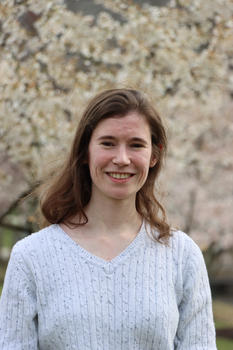In This Story
Just like miners used to bring canaries with them deep underground to detect danger early on, cherry trees – like the ones at George Mason University’s Fairfax campus – offer a similar advanced warning when it comes to the atmosphere.
Bloom date records of cherry trees go back over a thousand years, with the earliest recordings linked to ancient cherry blossom festivals in Japan. More recently, bloom dates have taken on another purpose. Because of their temperature sensitivity, cherry trees’ flowering times have been noted as good indicators of a changing climate.

Photo courtesy of Roth.
Biostatistics graduate student Jamie C. Roth wanted to apply this rich knowledge to the cherry trees that surround Mason Pond. She spearheaded a project to have the first weather station installed near the pond, which will monitor the atmosphere around the cherry trees and produce helpful data.
“The cherry blossoms show climate change better than any other plant,” said Roth. “I wanted to look at our own cherry trees and raise awareness of climate change.”
The weather station will be a permanent fixture and will measure components like sunlight, temperature, rainfall, humidity, and wind speed and direction. The data is then transmitted to a tablet that is currently housed in the Statistics department.
Although the team is working out the initial quirks of getting the system up and running, in time, Roth sees the weather station as a useful climate reporting tool for students to use in years to come.
“I’m excited for the future and to see how students get involved in climate change on campus,” said Roth.
Department of Statistics Assistant Professors David Kepplinger and Jonathan Auerbach supervised the project, along with College of Science Assistant Professor Daniel Hanley, in biology. Sarah D'Alexander from University Sustainability and Nick Valadez from the facilities department were instrumental in getting the weather station installed and running.
